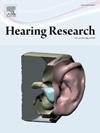正常听力成人的脑激活模式:一项使用适应性临床言语理解任务的fNIRS研究。
IF 2.5
2区 医学
Q1 AUDIOLOGY & SPEECH-LANGUAGE PATHOLOGY
引用次数: 0
摘要
目的:了解听觉和视觉语言的大脑加工对于推进语音感知研究和改善听力障碍患者的临床干预至关重要。功能性近红外光谱(fNIRS)被认为非常适合测量语言任务时的大脑活动。然而,准确的数据解释还需要有效的刺激和行为措施。设计:26名听力正常的成年人听了Oldenburg句子测试(OLSA)中的句子,并通过近红外光谱测量了颞、枕部和前额叶区域的大脑活动。这些句子以四种不同的方式之一呈现:无声语、嘈杂语、视听语或视觉语(即唇读)。为了支持我们对fNIRS数据的解释,并获得对研究人群更全面的了解,我们进行了听力测试(纯音和语音测听),并使用有效问卷、任务理解问题和听力努力评分收集行为数据。结果:在听觉条件下(即安静语音和噪音语音),我们观察到双侧颞区皮层活动。在视觉语言条件下,我们在枕区测量到显著的激活。在视听条件下,在两个区域都观察到皮层激活。此外,我们为听力正常的人在唇读过程中如何处理视觉线索建立了一个基线,我们发现,与安静的条件相比,噪音条件下前额叶皮层的活动更高,这与更高的听力努力有关。结论:我们证明了临床启发的视听语言理解任务在听力正常的参与者中的适用性。测量的大脑激活模式得到了客观和行为参数的支持和补充。本文章由计算机程序翻译,如有差异,请以英文原文为准。
Brain activation patterns in normal hearing adults: An fNIRS Study using an adapted clinical speech comprehension task
Objectives
Understanding brain processing of auditory and visual speech is essential for advancing speech perception research and improving clinical interventions for individuals with hearing impairment. Functional near-infrared spectroscopy (fNIRS) is deemed to be highly suitable for measuring brain activity during language tasks. However, accurate data interpretation also requires validated stimuli and behavioral measures.
Design
Twenty-six adults with normal hearing listened to sentences from the Oldenburg Sentence Test (OLSA), and brain activation in the temporal, occipital, and prefrontal areas was measured by fNIRS. The sentences were presented in one of the four different modalities: speech-in-quiet, speech-in-noise, audiovisual speech or visual speech (i.e., lipreading). To support the interpretation of our fNIRS data, and to obtain a more comprehensive understanding of the study population, we performed hearing tests (pure tone and speech audiometry) and collected behavioral data using validated questionnaires, in-task comprehension questions, and listening effort ratings.
Results
In the auditory conditions (i.e., speech-in-quiet and speech-in-noise), we observed cortical activity in the temporal regions bilaterally. During the visual speech condition, we measured significant activation in the occipital area. Following the audiovisual condition, cortical activation was observed in both regions. Furthermore, we established a baseline for how individuals with normal hearing process visual cues during lipreading, and we found higher activity in the prefrontal cortex in noise conditions compared to quiet conditions, linked to higher listening effort.
Conclusions
We demonstrated the applicability of a clinically inspired audiovisual speech-comprehension task in participants with normal hearing. The measured brain activation patterns were supported and complemented by objective and behavioral parameters.
求助全文
通过发布文献求助,成功后即可免费获取论文全文。
去求助
来源期刊

Hearing Research
医学-耳鼻喉科学
CiteScore
5.30
自引率
14.30%
发文量
163
审稿时长
75 days
期刊介绍:
The aim of the journal is to provide a forum for papers concerned with basic peripheral and central auditory mechanisms. Emphasis is on experimental and clinical studies, but theoretical and methodological papers will also be considered. The journal publishes original research papers, review and mini- review articles, rapid communications, method/protocol and perspective articles.
Papers submitted should deal with auditory anatomy, physiology, psychophysics, imaging, modeling and behavioural studies in animals and humans, as well as hearing aids and cochlear implants. Papers dealing with the vestibular system are also considered for publication. Papers on comparative aspects of hearing and on effects of drugs and environmental contaminants on hearing function will also be considered. Clinical papers will be accepted when they contribute to the understanding of normal and pathological hearing functions.
 求助内容:
求助内容: 应助结果提醒方式:
应助结果提醒方式:


